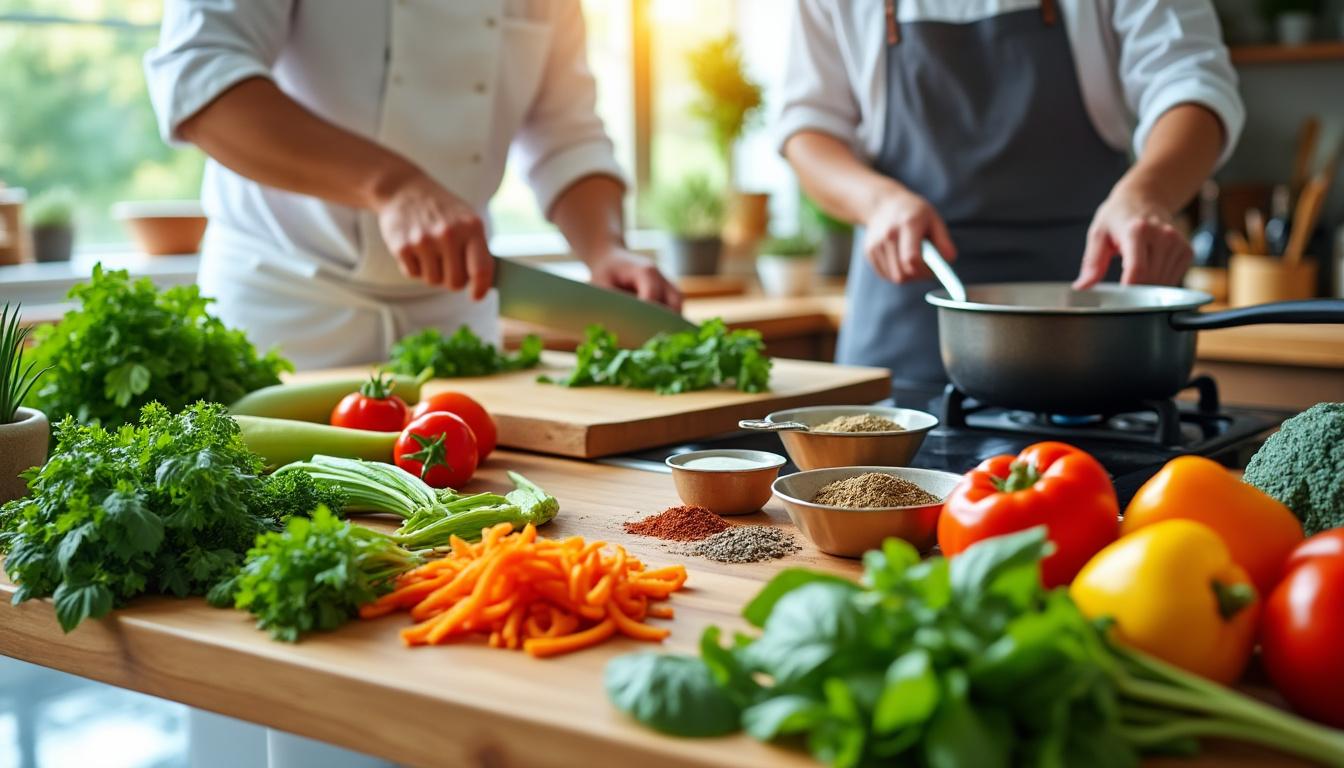Kitchen mastery guide for home cooks: learn knife skills, heat control, seasoning, and the best equipment choices to transform every kitchen routine and meal.
Mastering the Kitchen demands a blend of technique, organization and the right tools. This guide distills nine essential skills every aspiring home chef should acquire, from precise knife skills to confident heat control and efficient mise en place. Short, actionable sections pair practical lists, real-world examples and curated equipment notes to help readers upgrade their kitchen practice quickly.
Essential Knife Skills Every Home Chef Needs
Accurate cutting is the backbone of efficient cooking. In any kitchen, consistent knife technique improves speed, safety and evenness of cooking.
Why knife technique changes outcomes
Proper cuts affect texture and doneness. For example, uniform dice ensures vegetables cook evenly on a sauté and reduces wasted time correcting under- or overcooked elements. Investing time to practice yields immediate returns at the stove.
- Hold the knife with a controlled pinch grip for stability.
- Practice basic cuts: slice, dice, julienne, batonnet.
- Maintain a sharp blade with regular honing and periodic sharpening.
- Use a stable cutting board and the right knife type for the job.
Examples: a chef prepping a stir-fry with Henckels knives noticed faster, safer prep and more consistent plating. Final insight: mastering cuts reduces prep time and elevates the finished dish.
Heat Control and Doneness: Cook Like a Pro
Understanding heat transforms recipes into reliable results. Heat control affects browning, moisture retention and texture across proteins and vegetables.
Techniques to regulate heat
Recognize how different pans and burners distribute heat. A heavy skillet reaches and retains high temperatures, while a thinner pan heats quickly and cools fast. Adjust flame or induction settings to match the cookware and technique.
- Learn the stages of searing, medium and low simmering.
- Use an instant-read thermometer to confirm doneness on proteins.
- Allow carryover cooking when resting meats.
Pro tip: pairing an All-Clad stainless pan with proper flame control yields superior sear. Final insight: precise heat control turns guesswork into repeatable outcomes.
| Brand | Best Use | Why It Matters |
|---|---|---|
| KitchenAid | Stand mixer & attachments | Consistent mixing and dough development for baking |
| Cuisinart | Food processors | Speedy prep for sauces, chopping and purees |
| Le Creuset | Enamel Dutch ovens | Even braising and oven-to-table presentation |
| All-Clad | Precision searing and deglazing | Excellent heat conductivity for professional results |
| Vitamix | Smooth blending and hot soup from friction | Powerful, reliable texture control |
| Henckels | Chef and utility knives | Long-lasting edge and ergonomic handling |
| OXO | Everyday tools and measuring | User-friendly design that improves workflow |
| Instant Pot | Pressure cooking and multi-cook convenience | Speeds tough-cook recipes while preserving flavor |
| Breville | Precision appliances (toasters, ovens, espresso) | Consistent, reliable small-appliance performance |
| Lodge | Cast-iron skillets | Durable searing surface and heat retention |
Further reading on kitchen technique and culinary tips can be found in resources such as Inner Chef: Home Cooking and Cooking Tips & Culinary Skills. Final insight: matching the right pan to the heat is a multiplier for consistent results in any kitchen.
Mise en Place and Workflow: Organize for Speed
Mise en place is a discipline: it reduces errors and streamlines service. In the home kitchen, a few minutes of organization saves significant time during cooking.
Practical mise en place habits
Pre-measure spices, portion proteins and prepare produce before any heat goes on. Work left-to-right through tasks, and keep frequently used tools within reach.
- Set out ingredients in order of use to avoid scrambling during critical steps.
- Use labeled containers or bowls for mise en place when batch cooking.
- Clean as you go to maintain workspace efficiency.
Example: a small meal-prep service implemented mise en place and reduced cook time by 30%. Final insight: a deliberate setup is the quickest path to consistent results in a busy kitchen.
Seasoning, Flavor Building and Sauce Fundamentals
Seasoning is more than salt and pepper; it’s an understanding of balance, acid, fat and texture. Skillful seasoning defines a memorable dish in any kitchen.
Layering flavor step by step
Start with aromatics, build with browning, deglaze to capture fond, then finish with acid and fat to harmonize the dish. Taste at multiple stages rather than only at the end.
- Use salt in stages: during cooking and at finish for brightness.
- Balance with acid (vinegar, lemon) and fat (butter, olive oil).
- Experiment with fresh herbs at the end for aromatic lift.
Reference essays and recipes from authoritative cooks such as Alton Brown and Ina Garten illustrate how seasoning choices shape outcomes. Final insight: thoughtful seasoning converts good dishes into great ones.
Time-Saving Techniques, Smart Tools and Recipe Reading
Reading recipes like a pro and leveraging modern appliances shortens the learning curve. The smart use of tools keeps the kitchen productive and creative.
Appliances and shortcuts that work
Know when a gadget is a time-saver. The Instant Pot handles braises quickly; a Vitamix makes smooth purees instantly; a KitchenAid stand mixer takes over labor-intensive dough work. Choose tools that match typical weekly menus.
- Scan recipes fully before starting to avoid mid-prep surprises.
- Use multifunction appliances for batch tasks to free hands for plating.
- Prioritize versatile, quality pieces like cast iron and a reliable blender.
Explore practical hacks at sources such as Culinary Hacks and regional wisdom at Southern Kitchen Wisdom. Final insight: pairing recipe literacy with the right toolset accelerates mastery in any kitchen.
Plating, Presentation and Practical Service Skills
Presentation enhances perceived taste. Small plating adjustments—height, contrast and texture—elevate a simple home meal into a compelling plate.
Simple plating rules to apply now
Use the rule of three for components, vary textures, and choose a central focal point. Warm plates for hot dishes and wipe rims for clean presentation.
- Pair colors and textures for visual interest.
- Use micro-herbs or a drizzle of quality oil for finish.
- Practice plating with time constraints to simulate service pressure.
Examples from televised chefs and competitions provide staging approaches; see Top Chef Tips and practical chef anecdotes in Guy Fieri Cooking Tips. Final insight: presentation is a small investment that greatly enhances the dining experience.
Commonly Asked Practical Questions
How long does it take to master basic kitchen skills?
Developing reliable basic skills—knife work, heat control and mise en place—typically takes a few months of consistent practice. Short, focused sessions are more effective than occasional long ones.
Which tools should every home chef buy first?
Start with a quality chef’s knife (Henckels), a heavy skillet (Lodge or All-Clad), a reliable blender (Vitamix) and a stand mixer (KitchenAid) if baking is common. These items cover most techniques.
What is the best way to learn professional techniques at home?
Combine structured tutorials (video, books) with deliberate practice: cook the same recipe multiple times, refine one technique per week, and compare results. Recommended resources include Chef Jacques Pépin tips.
How can a busy cook maintain quality during the week?
Adopt mise en place for dinners, batch-cook components, and use multi-cookers like the Instant Pot to reduce active time without compromising flavor.

